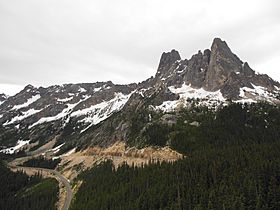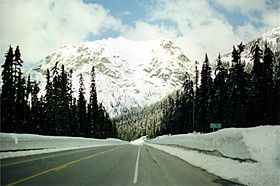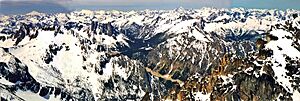Washington Pass facts for kids
Quick facts for kids Washington Pass |
|
|---|---|

State Route 20 and Liberty Bell Mountain at the pass, as seen from Washington Pass Overlook Trail
|
|
| Elevation | 5,477 ft (1,669 m) |
| Traversed by | State Route 20 |
| Location | Chelan / Okanogan counties, Washington, United States |
| Range | Cascades |
| Coordinates | 48°31.4′N 120°39.3′W / 48.5233°N 120.6550°W |
| Rainy Pass | |
|---|---|

Rainy Pass in spring
|
|
| Elevation | 4,875 ft (1,486 m) |
| Traversed by | State Route 20 |
| Location | Chelan / Skagit counties, Washington, United States |
| Range | Cascades |
| Coordinates | 48°31.1′N 120°44.1′W / 48.5183°N 120.7350°W |
Washington Pass and Rainy Pass are two important mountain passes located high in the North Cascades mountains of Washington state. They are part of State Route 20, also known as the North Cascades Highway. Washington Pass is 5,477 feet (1,669 meters) high, and Rainy Pass is 4,875 feet (1,486 meters) high. Rainy Pass is about 4 miles west of Washington Pass. Because of heavy snowfall, these passes are usually closed from November to April each year.
The famous Pacific Crest Trail, which runs north to south, crosses Highway 20 at Rainy Pass. Near Washington Pass, you can find the Washington Pass Overlook Trail. This short trail, only about 0.2 miles (0.3 kilometers) long, leads to a viewpoint. From there, you can see amazing views of Liberty Bell Mountain and the highway far below. This trail was named a National Recreation Trail in 1978.
Weather in the Mountains
Washington and Rainy Passes are in a special weather area called a marine west coast climate zone. This means the weather is often influenced by the ocean. Most of the weather systems that bring rain or snow start over the Pacific Ocean. They then travel northeast towards the Cascade Mountains.
How Mountains Make Weather
When these weather systems reach the North Cascades, the tall mountains force the air to rise. This process is called Orographic lift. As the air goes higher, it cools down and drops its moisture. This moisture falls as rain or snowfall onto the mountains. Because of this, the western side of the North Cascades gets a lot of precipitation, especially heavy snow in winter.
During the winter months, the weather is usually cloudy. However, in the summer, high-pressure systems over the Pacific Ocean often bring clear skies. The snow in this area tends to be wet and heavy because of the ocean's influence. This type of snow can lead to a high risk of avalanches. In fact, the North Cascades Highway, especially east of Washington Pass, is known for having many avalanche paths along its route.


